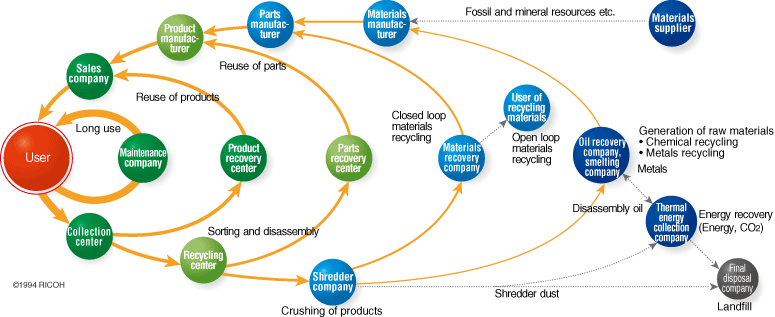- Home
- Sustainability
- Materiality for the Ricoh Group
- Approach to Materiality (Material issues)
Approach to Materiality (Material issues)Maximizing the use of resources from collected products to achieve a circular economy
Circular Economy
Background and issues
While socioeconomic activities based on mass production, consumption, and disposal have brought great benefits, they have also damaged and disrupted the environment and are unsustainable. It is therefore vital to materialize Circular Economy to minimize the consumption of resources and optimize energy efficiency to build a viable long-term future for humankind.
Serving the social good through business
Ricoh aims to contribute to a Circular Economy by doing its best to use resources efficiently. In keeping with the Comet Circle concept, we are pushing ahead with the use of resources that lower environmental impacts while pursuing economically efficient recycling, creating products that using fewer inputs of new resources.
As part of this effort, the Ricoh Group has offered refurbished machines since 1997. Used products collected from the market are disassembled into individual units or parts, and replacement is performed for parts or components requiring warranty or those for which replacement is mandatory under certain quality standards. The refurbished products represent Ricoh’s maximum efforts for the effective utilization of resources. Refurbished MFPs are supplied as the GreenLine series in Europe. Ricoh has subdivided the European market into three segments—advanced countries where the recycled product market is established; advanced countries where the market is developing; and emerging economy countries—in order to supply models that meet the needs of each segment.
 Comet Circle™ is Ricoh's concept of a Sustainable Society
Comet Circle™ is Ricoh's concept of a Sustainable Society
- Note:
- Comet Circle™ is Ricoh's concept of a Sustainable Society. It expresses the greater picture of our environmental impact reduction scheme, which includes not only the scope of the Ricoh Group as a manufacturer and sales company but also the entire lifecycle of our products, including upstream and downstream of our business activities. When the loop gets closer to users, the environmental impact declines and the economic efficiency increases. Ricoh is developing reusing and recycling technologies to move from the right to the left of the loop.
 GreenLine series in Europe
GreenLine series in Europe
Key Performance Indicators from Social Issues Perspectives
- <Goals for 2050> Virgin material usage rate: 12% or less
- <Goals for 2030> Virgin material usage rate: 60% or less
- Improve Resource conservation rate compared to previous fisical year